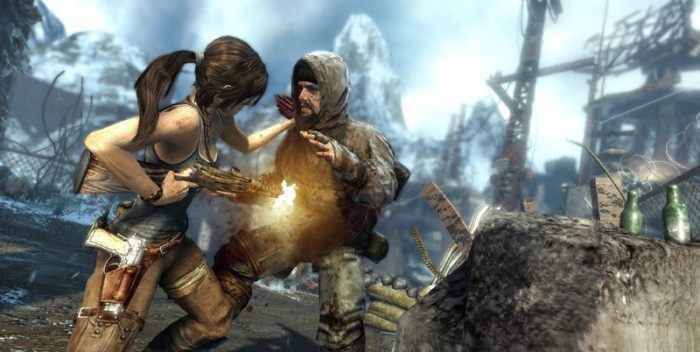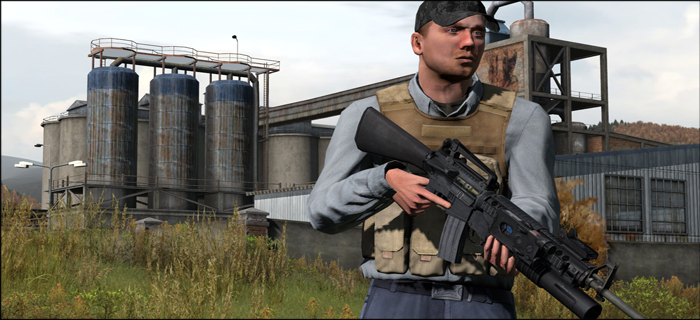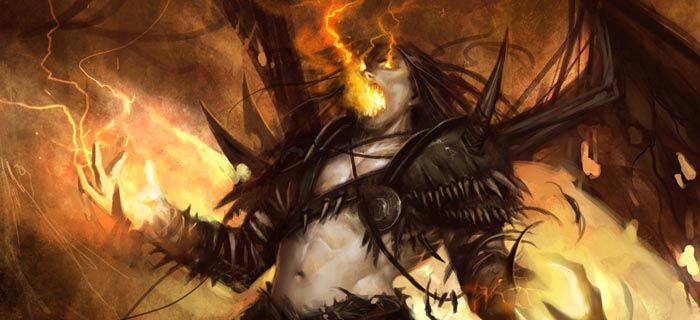Games aren’t murder simulators. They’re actually worse!
When Tomb Raider was given a facelift in 2013, the gamersphere went wild. Finally, here was a Lara Croft title that wasn’t stilted by terrible controls or moronic mechanics. A Tomb Raider with adventure, atmosphere, and heart.
So what news could be better than a sequel? And aside from some complaints about the title’s Xbox exclusivity, the onslaught of Lara Croft-related media was graciously received.
Enter the first official trailer for Rise of the Tomb Raider, wherein a psychologically damaged Croft struggles to contain nervous ticks as she relives experiences from her post-reboot adventures. She was, after all, nearly tortured, raped, and killed on dozens of occasions, with pretty much every bone in her body broken at some point along the way. The viewer is barraged with flashes of her trauma, each scene more terrible than the last.
I couldn’t help but laugh through the whole thing.
Poor Lara Croft! So young… so innocent. Yet despite her age and general inexperience, she had single-handedly murdered hundreds of other human beings in the 10 hours it took to beat her last game. By the end of her bloody rampage through Yamatai, Miss Croft had shot, stabbed, crushed, or immolated anything with a pair of working lungs. And that doesn’t even count all the spooky samurai who were just doing their jobs!
Lots of people would be quick to jump to Lara’s defense. “She didn’t murder anyone,” they’d say. “She was protecting herself and her friends from their own violent deaths!”
And while that was certainly true on many occasions (especially early in the narrative), things aren’t so crystal dynamics clear as the game progresses. Just a few hours into her killing spree, Lara learns that the island’s burly inhabitants were pretty much all abducted, stranded, or blackmailed into their service by the actual bad guy, Mathias.
Through diary entries and audio logs, the player discovers that most of the thugs shooting at Lara are just as scared, sad, and upset to be stuck on the island as she is. Most of these goons are only going along with the “evil” plot because they think it’ll help them escape Mathias and/or the island. On multiple occasions, you can even overhear them openly discussing the desire to give up the whole “being a violent asshole” thing.
I really enjoyed these heartfelt moments between NPCs, since these in-depth discussions gave me more time to line my crosshairs over their skulls before blowing their brains out. Sometimes when they were crying about missing their families, I would sneak up and plunge a climbing axe into their backs, right before emptying an assault rifle into their flailing bodies. And during a sequence when one guy confided to his best friend that he wasn’t interested in killing Lara, I lobbed a fire arrow into his buddy’s chest.
The whole scene was heartwarming, really.
A World Where Murder Makes Sense
It’s not hard to understand why critics of violent videogames have used the term “murder simulator.” I certainly murdered my fair share of human beings while playing Tomb Raider, a game that is nominally more of a “survival” story than a run-and-gun adventure. It was pretty much impossible to progress more than ten minutes in the game without stabbing an arrow into an otherwise unsuspecting person.
Gamers have always hated this term since it stigmatizes their hobby and reinforces the idea that videogames drive people to real-life violence. And strictly speaking, games don’t actually simulate or instruct the player on the how of murdering. Yet, in the broadest sense, most “action” games do simulate a world where murder –and only murder— is the means of progressing through the narrative.
So to be more accurate, we should say violent games are Murderverse Simulators.
What does that mean, exactly? Murderverse Simulators don’t mimic real life, or even realistic fantasies, but instead create paradigms where basic laws of physics and social interaction do not apply. In the bizarre alternate reality of most Murderverse Simulators:
- Your mouth is sealed, preventing you from reasoning with or intimidating others.
- Once engaged in combat, other people have no means of giving up, fleeing, or defecting.
- Only completely fatal damage can stop other people from fighting you with infinite resolve.
- Even when brutally injured, other people are physically unable to drop their weapons.
- For unfathomable reasons, various doors and bridges unlock when enough people die.
- Others will engage you even if they know you previously killed thousands of people.
Let’s think about just how these insane, reality-warping effects apply to a game like Tomb Raider. In the story, the extremely likeable Lara Croft assassinates her way through dozens and dozens of people who by all accounts have no remaining will to fight. Now she comes upon a random man who’s been left to guard a doorway for arbitrary reasons.
In real life, simply coming around the corner with a shotgun pointed at this man would be enough to force a conversation on Lara’s terms. “Drop your weapons, n-n-now,” she’d stammer out in her underdeveloped teenage voice. We imagine that Mr. Grunt, who is aware of his friends’ grisly deaths, would lay down his arms while possibly peeing himself just a little. “Look, I just want to go home, please don’t kill me,” he’d whine. “Please please please don’t shoot please, I just want to see my family again.” He would probably whimper on uncontrollably. From there, Lara would demand directions, ask questions, and possibly convince this sad sack to help her find Mathias.
Of course, we understand why this can’t happen in our Murderverse Simulator. There are too many variables. The A.I. involved is too complex. The controls necessary for such nuanced interaction don’t exist. Developers simply cannot create gaming environments where reasonable interaction is possible.
Except they can and they have. And ironically enough, the most humane scenarios in adversarial combat exist in the world of sandbox gaming.
Finding Common Ground
Yes, sandboxes – the quasi-genre most well known for trolling, backstabbing, scamming, paranoia, and rage-quitting. If you’re not familiar with the term, sandboxes are typically unstructured open-world games where players are free to interact with the environment and other players as they see fit, often to hilarious results. These games (like Rust, EVE Online, DayZ, and Minecraft) are actually some of the only places where personal interactions aren’t forced into a Murderverse Simulator paradigm.
Most people would guess that worlds without rules would necessarily lead to ruthless, cruel behavior. That humans will, unless otherwise prevented, resort to the most barbaric acts possible. But it turns out the exact opposite is true. When presented with nearly unlimited action options, humans regularly choose friendly, diplomatic, or hilarious routes instead.
Here’s a popular clip from the zombie survival sandbox DayZ. Considering any player can kill any other player at any time, it’s refreshing to see that not every meetup has to immediately devolve into violence.
Sure, most of the time you encounter a stranger in a sandbox game he’s going to end your virtual existence, but it doesn’t have to be that way. You can beg for your life. You can lure him into a trap. Hell, you can bargain for your existence, something that led to the player-created ransoming mechanic in EVE Online.
Of course this flexibility is inherently tied to the multiplayer aspect of these sandbox titles. With real humans at the helm of most characters, there’s a lot more room for meaningful interactions. We’re still not at the point where NPCs can respond to things like “Tell me a joke or I’ll shoot your arm off.” But as technology progresses and game designers consider options other than Murderverse Simulators, we can only hope we’ll one day have more honest interactions with Lara Croft’s enemies. That way, they too can live to seek professional therapy.









I think we’re all hoping that the next one gets back (at least partially) to the actual “Tomb Raiding” and away from the “Murderverse Simulator” thing. I mean, I loved the TR reboot, but I’ll gladly admit that it got a bit much by the end of the game. I think they were trying too hard to be Uncharted (another series that I love, but which always was just trying to be “Guy Tomb Raider,” which makes TR trying to be more like it kind of ironic, I guess…)
I drop a leave a response each time I like a post on a site or if
I have something to valuable to contribute to the discussion. Usually
it is caused by the passion displayed in the post I browsed.
And after this article Games aren
So you’re the type of person to thumbs up their own comment eh.
You would like skyrim, every third person begs for mercy before you kill them but you can’t stop.
Games like Tomb Raider aren’t very interactive because it’s not good for business. You’re not supposed to play one game for hundreds of hours, trying various ways to beat it or trying to see characters behave different way on each playthrough. You pick up (or even better preorder) a game, play it for 10 hours or so, murder the 600 enemies or so and drive to retail store to get another $60 game that will last you another 10 hours.
Sure games like Skyrim exist, where you create or download tons of mods and can easily put 1000 hours in it, but they are in vast minority. Also, more and more games deliberately are developed for consoles and only come to PC as lazy ports so that you’re less likely to get mods from the community and are forced to pay for terrible DLC that adds 30 minutes if you’re lucky (if not, you just paid for some pink camouflage for your gun which is 100% cosmetic).
Dunno if you’re going to read it. I just came upon this article and felt like writing it. Cheers.
i have to say from the title i was expecting a very different kind of article and i have to say i’m glad you didn’t go that way.
Random modder: Quickly builds a Skyrim mod of Lara with dual wielding axes and gives her a gruff drunk voice over!